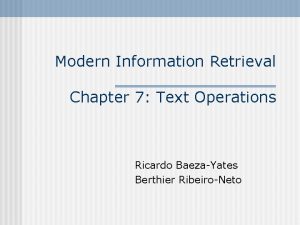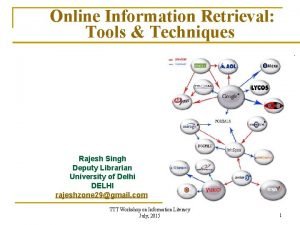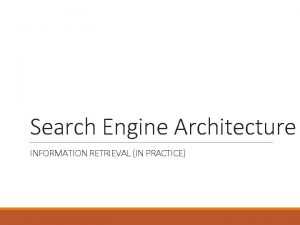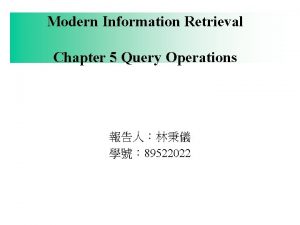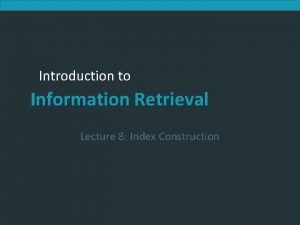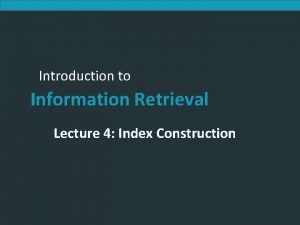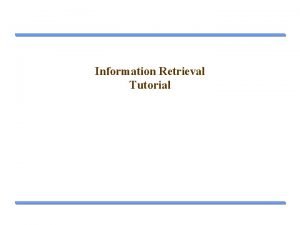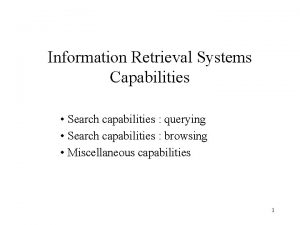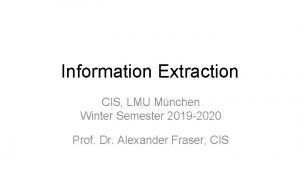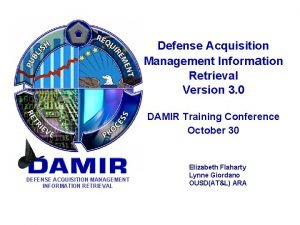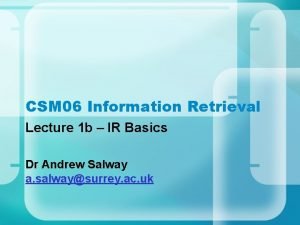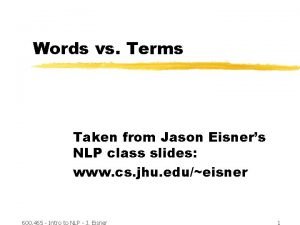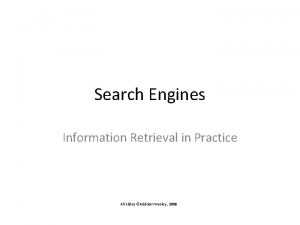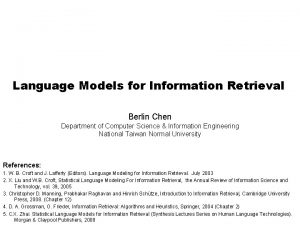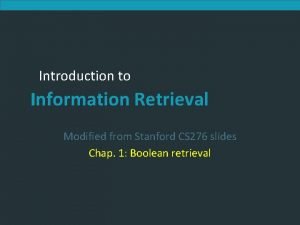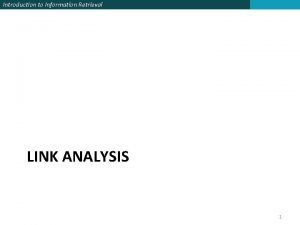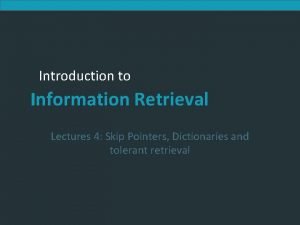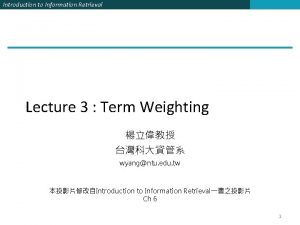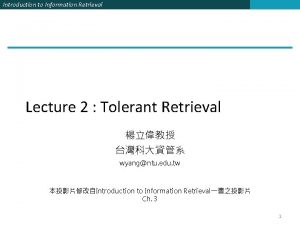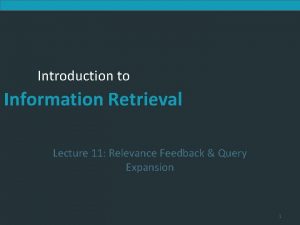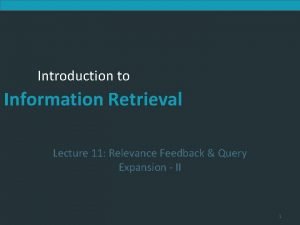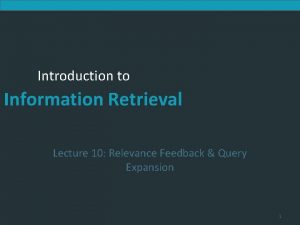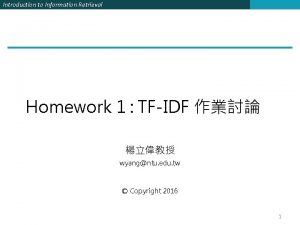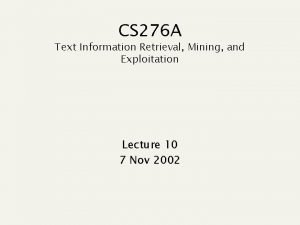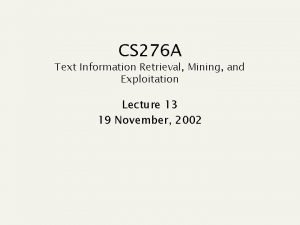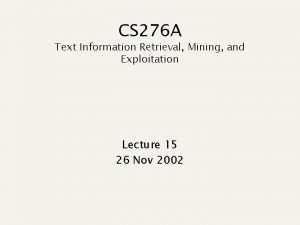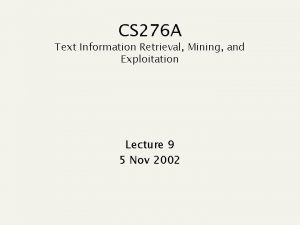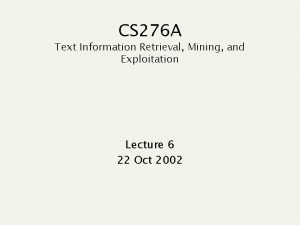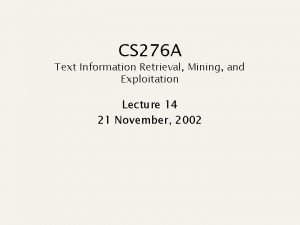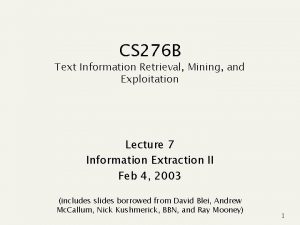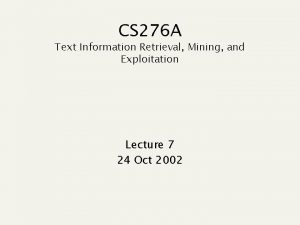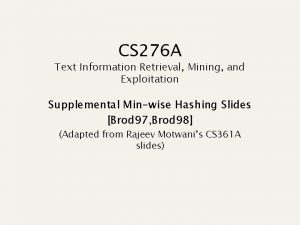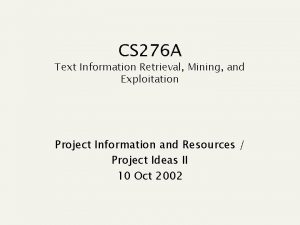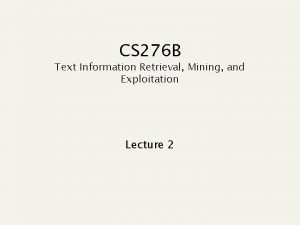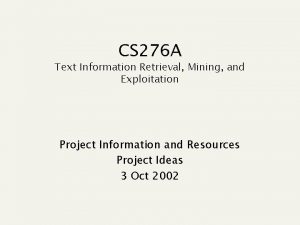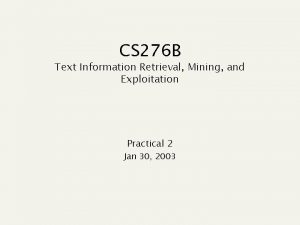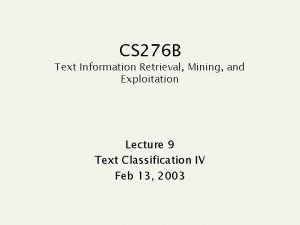CS 276 A Text Information Retrieval Mining and










































- Slides: 42

CS 276 A Text Information Retrieval, Mining, and Exploitation Lecture 2 1 Oct 2002

Course structure & admin n CS 276: two quarters this year: n CS 276 A: IR, web (link alg. ), (infovis, XML, P 2 P) n n n Website: http: //cs 276 a. stanford. edu/ CS 276 B: Clustering, categorization, IE, bio Course staff Textbooks Required work Questions?

Today’s topics n Inverted index storage (continued) n n Processing Boolean queries n n n Compressing dictionaries in memory Optimizing term processing Skip list encoding Wild-card queries Positional/phrase/proximity queries Evaluating IR systems – Part I

Dictionary and postings files: a fast, compact inverted index Usually in memory Gapencoded,

Inverted index storage n n Last time: Postings compression by gap encoding This time: Dictionary storage n Dictionary in main memory, postings on disk n n This is common, especially for something like a search engine where high throughput is essential, but can also store most of it on disk with small, in‑memory index Tradeoffs between compression and query processing speed n Cascaded family of techniques

How big is the lexicon V? n n n n Grows (but more slowly) with corpus size Exercise: Can one Empirically okay model: derive this from b V = k. N Zipf’s Law? where b ≈ 0. 5, k ≈ 30– 100; N = # tokens For instance TREC disks 1 and 2 (2 Gb; 750, 000 newswire articles): ~ 500, 000 terms Number is decreased by case-folding, stemming Indexing all numbers could make it extremely large (so usually don’t*) Spelling errors contribute a fair bit of size

Dictionary storage - first cut n Array of fixed-width entries n 500, 000 terms; 28 bytes/term = 14 MB. Allows for fast binary 20 bytes search into dictionary 4 bytes each

Exercises n n Is binary search really a good idea? What are the alternatives?

Fixed-width terms are wasteful n Most of the bytes in the Term column are wasted – we allot 20 bytes for 1 letter terms. n n Written English averages ~4. 5 characters. n n And still can’t handle supercalifragilisticexpialidocious. Exercise: Why is/isn’t this the number to use for estimating the dictionary size? Short words dominate token counts. Average word type in English: ~8 characters. Store dictionary as a string of characters: n n Pointer of next word shows end of last Hope to save up to 60% of dictionary space.

Compressing the term list …. systilesyzygeticsyzygialsyzygyszaibelyiteszczecinszomo…. Total string length = 500 KB x 8 = 4 MB Pointers resolve 4 M positions: log 24 M = 22 bits = 3 bytes Binary search these pointers

Total space for compressed list n n n 4 bytes per term for Freq. 4 bytes per term for pointer to Postings. 3 bytes per term pointer Avg. 8 bytes per term in term string Now avg. 11 bytes/term, 500 K terms 9. 5 MB not 20.

Blocking n n Store pointers to every kth on term string. Need to store term lengths (1 extra byte) …. 7 systile 9 syzygetic 8 syzygial 6 syzygy 11 szaibelyite 8 szczecin 9 szomo…. Save 9 bytes on 3 pointers. Lose 4 bytes on term lengths.

Exercise n Estimate the space usage (and savings compared to 9. 5 MB) with blocking, for block sizes of k = 4, 8 and 16.

Impact on search Binary search down to 4 -term block; Then linear search through terms in block. 8 documents: binary tree ave. = 2. 6 compares Blocks of 4 (binary tree), ave. = 3 compares n n 5 3 7 2 4 6 8 1 = (1+2∙ 2+4∙ 3+4)/8 =(1+2∙ 2+2∙ 3+2∙ 4+5)/8 1 5 2 6 3 7 4 8

Extreme compression (see MG) n Front-coding: n n Using perfect hashing to store terms “within” their pointers n n Sorted words commonly have long common prefix – store differences only (for 3 in 4) not good for vocabularies that change. Partition dictionary into pages n n n use B-tree on first terms of pages pay a disk seek to grab each page if we’re paying 1 disk seek anyway to get the postings, “only” another seek/query term.

Compression: Two alternatives n Lossless compression: all information is preserved, but we try to encode it compactly n n What IR people mostly do Lossy compression: discard some information n Using a stoplist can be thought of in this way Techniques such as Latent Semantic Indexing (17 Oct) can be viewed as lossy compression One could prune from postings entries unlikely to turn up in the top k list for query on word n Especially applicable to web search with huge numbers of documents but short queries n e. g. , Carmel et al. SIGIR 2002

Boolean queries: Exact match n An algebra of queries using AND, OR and NOT together with query words n n What we used in examples in the first class Uses “set of words” document representation Precise: document matches condition or not Primary commercial retrieval tool for 3 decades n n Researchers had long argued superiority of ranked IR systems, but not much used in practice until spread of web search engines Professional searchers still like boolean queries: you know exactly what you’re getting n Cf. Google’s boolean AND criterion

Query optimization n Consider a query that is an AND of t terms. The idea: for each of the t terms, get its term -doc incidence from the postings, then AND together. This is why Process in order of increasing freq: we kept freq in dictionary n start with smallest set, then keep cutting further.

Query processing exercises n n If the query is friends AND romans AND (NOT countrymen), how could we use the freq of countrymen? How can we perform the AND of two postings entries without explicitly building the 0/1 term-doc incidence vector?

General query optimization n e. g. , (madding OR crowd) AND (ignoble OR strife) n n Can put any boolean query into CNF Get freq’s for all terms. Estimate the size of each OR by the sum of its freq’s (conservative). Process in increasing order of OR sizes.

Exercise n Recommend a query processing order for (tangerine OR trees) AND (marmalade OR skies) AND (kaleidoscope OR eyes)

Speeding up postings merges n n Insert skip pointers Say our current list of candidate docs for an AND query is 8, 13, 21. n (having done a bunch of ANDs) We want to AND with the following postings entry: 2, 4, 6, 8, 10, 12, 14, 16, 18, 20, 22 Linear scan is slow.

Augment postings with skip pointers (at indexing time) 2, 4, 6, 8, 10, 12, 14, 16, 18, 20, 22, 24, . . . n n n At query time: As we walk the current candidate list, concurrently walk inverted file entry - can skip ahead n (e. g. , 8, 21). Skip size: recommend about (list length)

Caching n n If 25% of your users are searching for Britney Spears then you probably do need spelling correction, but you don’t need to keep on intersecting those two postings lists Web query distribution is extremely skewed, and you can usefully cache results for common queries

Query vs. index expansion n Recall, from lecture 1: n n n thesauri for term equivalents soundex for homonyms How do we use these? n Can “expand” query to include equivalences n n Query car tyres automobile tires Can expand index n Index docs containing car under automobile, as well

Query expansion n Usually do query expansion n n No index blowup Query processing slowed down n n May retrieve more junk n n Docs frequently contain equivalences puma jaguar Carefully controlled wordnets

Wild-card queries: * n n mon*: find all docs containing any word beginning “mon”. Easy with binary tree (or B-Tree) lexicon: retrieve all words in range: mon ≤ w < moo *mon: find words ending in “mon”: harder Permuterm index: for word hello index under: n n hello$, ello$h, llo$he, lo$hel, o$hell Queries: n n n X lookup on X$ *X lookup on X$* X*Y lookup on Y$X* X* lookup on X*$ *X* lookup on X* X*Y*Z ? ? ? Exercise!

Wild-card queries n n n Permuterm problem: ≈ quadruples lexicon size Another way: index all k-grams occurring in any word (any sequence of k chars) e. g. , from text “April is the cruelest month” we get the 2 -grams (bigrams) $a, ap, pr, ri, il, l$, $i, is, s$, $t, th, he, e$, $c, cr, ru, ue, el, le, es, st, t$, $m, mo, on, nt, h$ n $ is a special word boundary symbol

Processing n-gram wild-cards n n n Query mon* can now be run as n $m AND mo AND on Fast, space efficient But we’d get a match on moon. Must post-filter these results against query. Further wild-card refinements n n Cut down on pointers by using blocks Wild-card queries tend to have few bigrams n n keep postings on disk Exercise: given a trigram index, how do you process an arbitrary wild-card query?

Phrase search n n n Search for “to be or not to be” No longer suffices to store only <term: docs> entries But could just do this anyway, and then post -filter [i. e. , grep] for phrase matches n n Viable if phrase matches are uncommon Alternatively, store, for each term, entries n <number of docs containing term; n doc 1: position 1, position 2 … ; n doc 2: position 1, position 2 … ; n etc. >

Positional index example <be: 993427; 1: 7, 18, 33, 72, 86, 231; 2: 3, 149; 4: 17, 191, 291, 430, 434; 5: 363, 367, …> n n Which of these docs could contain “to be or not to be”? Can compress position values/offsets as we did with docs in the last lecture Nevertheless, this expands postings list in size substantially

Processing a phrase query n n Extract inverted index entries for each distinct term: to, be, or, not Merge their doc: position lists to enumerate all positions where “to be or not to be” begins. n to: n n be: n n 2: 1, 17, 74, 222, 551; 4: 8, 27, 101, 429, 433; 7: 13, 23, 191; . . . 1: 17, 19; 4: 17, 191, 291, 430, 434; 5: 14, 19, 101; . . . Same general method for proximity searches

Example: West. Law n n Largest commercial (paying subscribers) legal search service (started 1975; ranking added 1992) About 7 terabytes of data; 700, 000 users Majority of users still use boolean queries Example query: n n n http: //www. westlaw. com/ What is the statute of limitations in cases involving the federal tort claims act? LIMIT! /3 STATUTE ACTION /S FEDERAL /2 TORT /3 CLAIM Long, precise queries; proximity operators; incrementally developed; not like web search

Evaluating an IR system – Part I n What are some measures for evaluating an IR system’s performance? n n n Speed of indexing Index/corpus size ratio Speed of query processing “Relevance” of results Note: information need is translated into a boolean query Relevance is assessed relative to the information need not the query

Standard relevance benchmarks n n n TREC - National Institute of Standards and Testing (NIST) has run large IR testbed for many years Reuters and other benchmark sets used “Retrieval tasks” specified n n sometimes as queries Human experts mark, for each query and for each doc, “Relevant” or “Not relevant” n or at least for subset that some system returned

Precision and recall n n Precision: fraction of retrieved docs that are relevant = P(relevant|retrieved) Recall: fraction of relevant docs that are retrieved = P(retrieved|relevant) Relevant Not Relevant tp fp Not Retrieved fn tn Retrieved n n Precision P = tp/(tp + fp) Recall R = tp/(tp + fn)

Why not just use accuracy? n How to build a 99. 9999% accurate search engine on a low budget…. Search for: n People doing information retrieval want to find something and have a certain tolerance for junk

Precision/Recall n n Can get high recall (but low precision) by retrieving all docs for all queries! Recall is a non-decreasing function of the number of docs retrieved n n Precision usually decreases (in a good system) Difficulties in using precision/recall n n n Should average over large corpus/query ensembles Need human relevance judgements Heavily skewed by corpus/authorship

A combined measure: F n n Combined measure that assesses this tradeoff is F measure (weighted harmonic mean): People usually use balanced F 1 measure n n i. e. , with = 1 or = ½ Harmonic mean is conservative average n See CJ van Rijsbergen, Information Retrieval

F 1 and other averages

Resources for today’s lecture n Managing Gigabytes, Chapter 4 n n n Sections 4. 0 – 4. 3 and 4. 5. Modern Information Retrieval, Chapter 3. Princeton Wordnet n http: //www. cogsci. princeton. edu/~wn/

Glimpse of what’s ahead n n Building indices Term weighting and vector space queries Probabilistic IR User interfaces and visualization n n Link analysis in hypertext Web search Global connectivity analysis on the web XML data Large enterprise issues
 Text and web mining
Text and web mining Text operations in information retrieval
Text operations in information retrieval Text-to-media connection
Text-to-media connection Text analytics and text mining
Text analytics and text mining Text analytics and text mining
Text analytics and text mining Difference between strip mining and open pit mining
Difference between strip mining and open pit mining Recall and precision in information retrieval
Recall and precision in information retrieval Information retrieval and web search
Information retrieval and web search Information retrieval data structures and algorithms
Information retrieval data structures and algorithms Examples of information retrieval tools
Examples of information retrieval tools Information retrieval data structures and algorithms
Information retrieval data structures and algorithms Strip mining vs open pit mining
Strip mining vs open pit mining Strip mining vs open pit mining
Strip mining vs open pit mining Mining multimedia databases
Mining multimedia databases Mining complex types of data in data mining
Mining complex types of data in data mining Text based image retrieval
Text based image retrieval Text retrieval software
Text retrieval software Sequential searching
Sequential searching Components of search engine in information retrieval
Components of search engine in information retrieval Query operations in information retrieval
Query operations in information retrieval Skip pointer information retrieval
Skip pointer information retrieval Index construction in information retrieval
Index construction in information retrieval Bsbi vs spimi
Bsbi vs spimi Which internet service is used for information retrieval
Which internet service is used for information retrieval Information retrieval tutorial
Information retrieval tutorial Wildcard queries in information retrieval
Wildcard queries in information retrieval Search capabilities in information retrieval system
Search capabilities in information retrieval system Link analysis in information retrieval
Link analysis in information retrieval Information retrieval lmu
Information retrieval lmu Defense acquisition management information retrieval
Defense acquisition management information retrieval Advantages of information retrieval system
Advantages of information retrieval system Information retrieval nlp
Information retrieval nlp Information retrieval slides
Information retrieval slides Relevance information retrieval
Relevance information retrieval Stanford information retrieval
Stanford information retrieval Link analysis in information retrieval
Link analysis in information retrieval Skip pointer
Skip pointer Anthony julius
Anthony julius Information retrieval
Information retrieval Information retrieval
Information retrieval Information retrieval
Information retrieval Relevance information retrieval
Relevance information retrieval Information retrieval
Information retrieval

